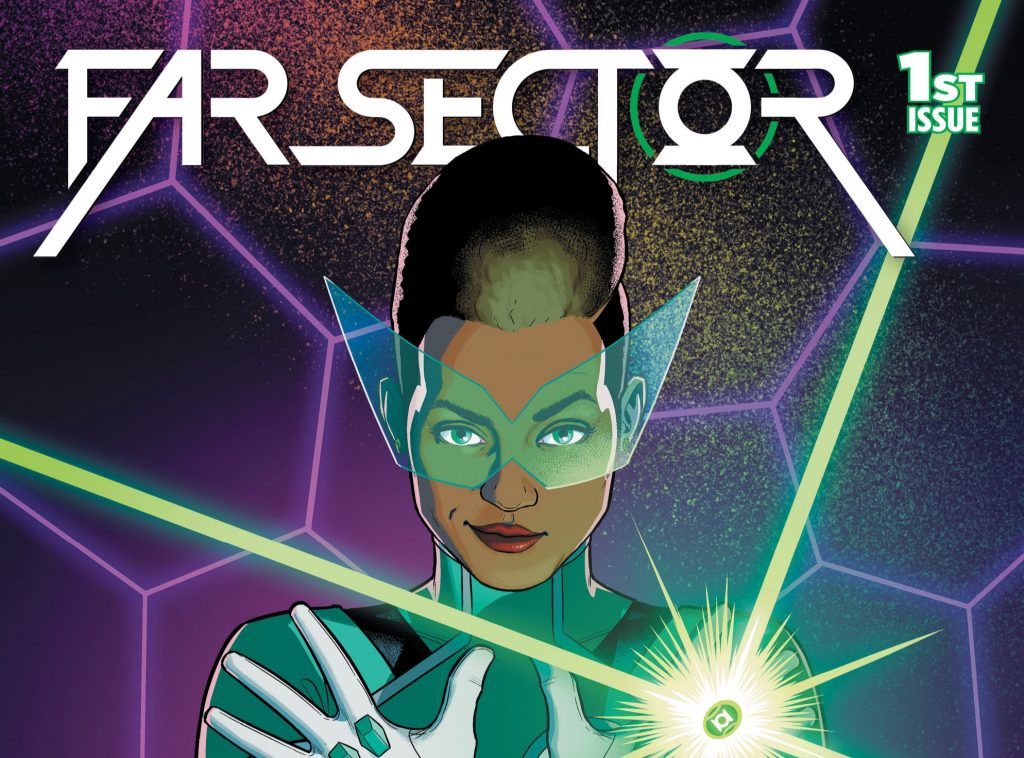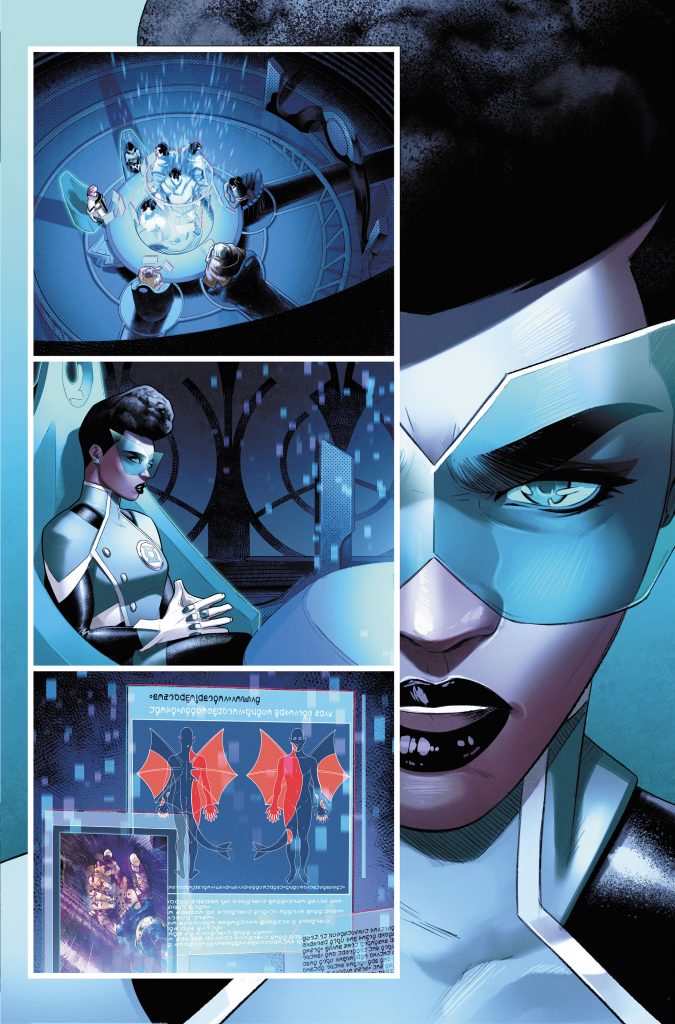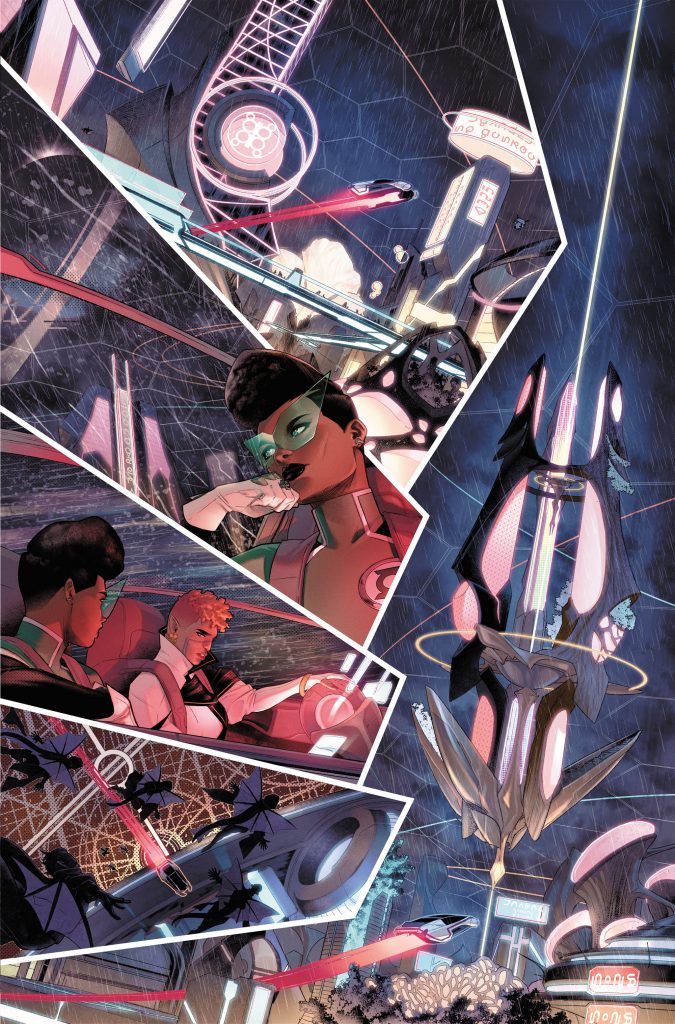
Written by Eric Cahill
Far Sector by Hugo Award winner N.K. Jemisin and Jamal Campbell debuts this week to give us what’s been advertised as a bold new frontier in the Green Lantern world. Does it live up to its promotion?
The story starts with a murder mystery in a place alien to not just us but our protagonist as well. Newly introduced Lantern ‘Jo’ Mullein is on assignment in the titular Far Sector – so remote and previously unmonitored that it either (irresponsibly on the Guardians part) doesn’t have a sector number or just that (irresponsibly on Mullein’s part) our hero just cant remember it. A giant city-planet home to a “trilogy” of people, each with their own extreme biologies living in peace with a shared culture of repressed emotion. In this first issue, we’re introduced at a rapid pace to the different peoples, their cultures, and what it means when murder is introduced to centuries of peace – told through the engaging narration of a hero who feels just as alien to these people as they do to us.
Jemisin set herself a tall order. They have to set up a brand new world (literally) with multiple cultures, introduce a new character into an iconic comic legacy, set up a dozen other side characters with their own hang ups, and perhaps most importantly wrap all that into a plot that utilizes them all effectively. And she more or less succeeds.

Personally I’ve felt for a while that the Green Lantern concept needs to better define itself. What makes it stand out versus the other caped crusaders on the stands? Jemisin seems to take that challenge to heart. The story taps into what is a unique and ideal niche for them. They’re alien cops – and what that means is that they have to solve crimes in cultures far beyond what we – or they – have experienced in our lives. And in space! Sky high imagination is right there baked into their very power set. In ‘Sector’, the authors use the bare bones of a murder mystery to tell a story that lives in that science fiction fantasy world that suits the Lanterns. The society built here has a history, with details designed to make it feel lived in. The Lantern herself is a new character, and thankfully after a few arguably generic additions to the mythos the last few years, feels fleshed out. She has her own hang ups and foibles, her own voice. And that extends to the supporting cast as well.
There are characters with divisive ideologies, dynastic politics, and societal structures that are layered in such a way that you can imagine a myriad of stories coming from the setting alone. There are a few problems with the execution. Likely by necessity, this issue is wall to wall exposition. That’s not necessarily a bad thing. And to its credit, the writing does its best to present all this in as entertaining a way as possible and get it all across via character rather than just a flat download of info. Most of that we get through Mulleins narration.
Rather than a big dreamer with wide eyes at the wonders we see unfold, she instead seems to be aggravated or resentful towards it all. It’s a unique take on a Lantern. She seems a bit of a grump, but at the same time she’s not a cliched old curmudgeon. She seems to be a rookie with some mysterious backstory. And while this gives the info dumps flavor, it actually becomes a problem by the end of the issue. A vast majority of the exposition we get is through the main character mostly complaining. She seems perpetually annoyed by the culture and judgmental in general.
Who gives a shit if she’s likable (though to be fair she is very likable) but it’s the entire comic, and the first issue! By the time its over you start to wonder if you should give a shit either. Especially considering the culture she’s describing seems to mostly be irritating her because of its complexity, not necessarily its actual shortcomings. She mentions how dangerous some of the aliens are, or how negative their consciously emotionless culture must be. But we don’t really get any sense of danger or why the repression is a negative (besides our general understanding of that being a bad thing). So it seems like the character whose thoughts are literally driving the story is antithetical to the story’s premise. Which – hey – I’m willing to hope is maybe the point. She describes a character as problematic and arrogant (who incidentally doesn’t really seem either in this issue) while at the same time implying an inexorable attraction to the person. She appreciates the beauty of the world when it looks most real, not when it looks most aesthetically pleasing. And the brief, mysterious flashbacks let us know there’s more going on here than meets the eye. So in the context of this entire story, it could be thematic.
Maybe her growth is part of the journey. But then again, she also says she grew to love the place in much less than a year but then spends twenty plus pages complaining about it – so just within the physical confines of this issue its a bit relentless.

Like I said, I like Mullein and I like her voice. It’s extremely tricky to do the noir bit in this day and age and not sound like a hack or parody. In here the narration is genuinely entertaining. The control of language and modern sensibility to the tone is spot on. But if your lead is this dismissive of the first murder in a century, it’s a bit harder to be on her side. The world building is fun as well and despite the tricky juggling of its density, it is nice to get so MUCH of it. It’s at times maybe a bit derivative or hodge-podgey but then again it is the first issue and I have faith in the strength of the writing that the concepts will be satisfyingly explored.
I will say its odd that they’re a society with physically constrained emotions and yet their head council demonstrate what at times can – objectively – be called turned up behavior. It’s that juggle, sometimes the balls fall. And Mullein lampshading that on the page seems more like damage control than foreshadowing. As to the art, it’s attractive as hell but comes off a little cluttered. The design work for Mullein is a lot of fun and its a good reminder that Lanterns are creative characters and they can get away with a lot in their dress code. Her uniform has fantastic style and seems completely non-militaristic and maybe impractical – but that’s great! Lantern suits are made of hard light, their forcefields act as armor. They don’t need to worry about the constraints of the physical world; they don’t need to wear riot gear to fight or dress like old wrestlers due to tradition. Mullein’s got a distinct 80’s fashion advertisement design via pop cultural modernity and I’m into it. I’m a toy guy and I’d love to see this translated into something I can play with or display. The rest of the design isn’t bad but doesn’t stand out as much. There’s some danger of seeming like its copying the worlds current most popular space fantasy comic published by an Image conscious competitor. And at this point in my comic reading life, city planets are all starting to look alike.
Sometimes the concept of unlimited imagination as written can be a little underwhelming when executed. The storytelling is a little muted as well. I think that’s more the expositional nature of the issue. Campbell seemed to try and get in some solid compositions while they could. Like the opening splash. With a very alien but also very familiar hand in a very familiar crime scene image, the stage is set perfectly. Another standout moment had Mullein “holding” the City Enduring in her hand that, coupled with the accompanying dialogue, was a great moment that really sells this writer/artist combination. Overall the art is hindered by the coloring. In what is a house style and/or an attempt to make everything look like we’re on an alien world, washes everything out with omnipresent color. It’s a regular problem in DC comics I’ve seen, where they need to have the distinctions of the page pop with color more. My eyes should be drawn to sections, not gloss over the page. Campbell is doing some strong work, its a shame it can get lost in his own coloring.
Overall I enjoyed it and want more of this density and this world in particular. I just wasn’t in love with the way it was executed here. I am however a huge champion of the concept and am eager to read the series as it goes. For all the clutter, its easy to see how the characters can break out and the creators have the right head about how to approach this material. This seems like a case where it’s tricky to judge a series issue by issue. I’m excited to see more. In a lot of ways, this is Green Lantern as it was meant to be.
Far Sector #1 earns 4 out of 5